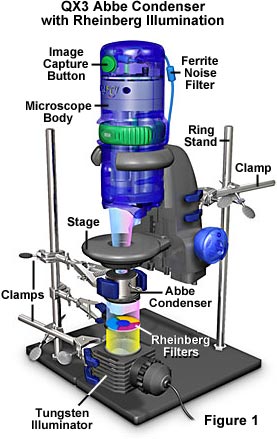Advanced Condenser Systems: Abbe Condensers
Rheinberg Illumination
Digital Image Gallery
Rheinberg illumination, a form of optical staining, was initially demonstrated by the British microscopist Julius Rheinberg to the Royal Microscopical Society and the Quekett Club (England) nearly a hundred years ago. This technique is a striking variation of low to medium power darkfield illumination using colored gelatin or glass filters to provide rich color to both the specimen and background.

In Rheinberg illumination (illustrated in Figure 1), which is related to darkfield, several kinds and shapes of filters are used. The oblique or outer light rays coming through a wide-open bright-field Abbe condenser pass through an annular (doughnut-shaped) filter of one or more colors (shown as the red, yellow, and blue filter in Figure 1). The central rays of light pass through another spot-shaped filter fitting into the circular opening of the annular-shaped filter (the dark blue central filter in figure 1). The objective is used at full aperture. In this particular case, the specimen would appear as a mixture of red, yellow, and blue on a deep blue background.
We have investigated optical microscopy in Rheinberg illumination mode using a variety of filters with the configuration presented in Figure 1, and have assembled a gallery of digital images created with the QX3 body coupled to an Abbe condenser. Use the links below to navigate to individual photomicrographs of specimens photographed with the QX3 computer microscope equipped for advanced Rheinberg illumination.
Atropine - Atropine is an anticholinergic agent that is a potent parasympatholytic, inhibiting actions of acetylcholine at postganglionic parasympathetic neuroeffector sites. It is a competitive antagonist of acetylcholine at smooth and cardiac muscles and various glandular cells.
Culex (Mosquito) - The Culex genus of mosquitoes has a worldwide distribution and is found on every continent except Antarctica. Fourteen species occur throughout the United States and Canada. Many species of Culex are known as the "house mosquito" because these insects commonly develop in small containers around houses.
Hadrosaur Bone - The hadrosaurs, often referred to as the "duckbilled dinosaurs", were a group of plant-eating dinosaurs that evolved during the Jurassic era, 135-205 million years ago. By the end of the Cretaceous era, 65 million years ago, they were widely distributed in Europe, Asia, and North America.
PABA - Para-aminobenzoic acid (PABA), a component of pteroylglutamate, was once considered a vitamin and named vitamin B-x because it serves as a provitamin for some bacteria. Later studies in humans demonstrated that it does not have vitamin activity because humans lack the ability to synthesize folate from PABA.
Silkworm Larva - "Silkworm" is the common name for silk-producing larvae of any of several species of moths. The most widely known is the common, domesticated silkworm that was originally cultivated by the Chinese 5,000 years ago. These celebrated moths produce $200-$500 million worth of silk every year.
Tylenol - Tylenol is one of over 100 brand names of the analgesic acetaminophen that acts quickly and safely to provide temporary relief of minor headaches, minor muscular aches, overexertion, menstrual cramps, and many other ailments. Acetaminophen, the active ingredient in Tylenol, has made this drug a popular over-the-counter pain reliever.
BACK TO THE INTEL PLAY ADVANCED DIGITAL IMAGE GALLERY
